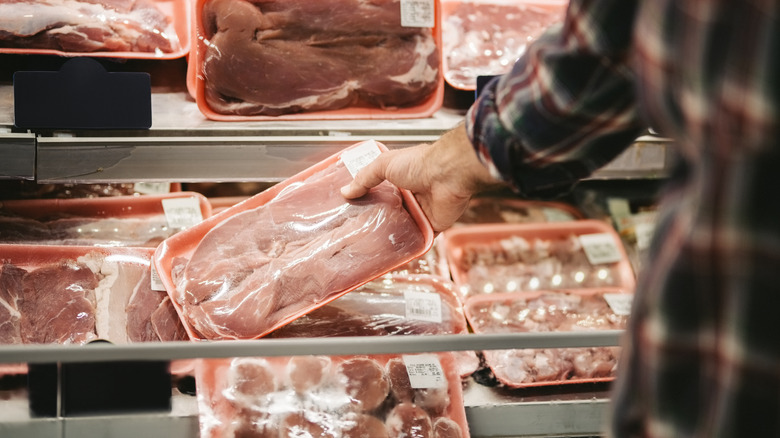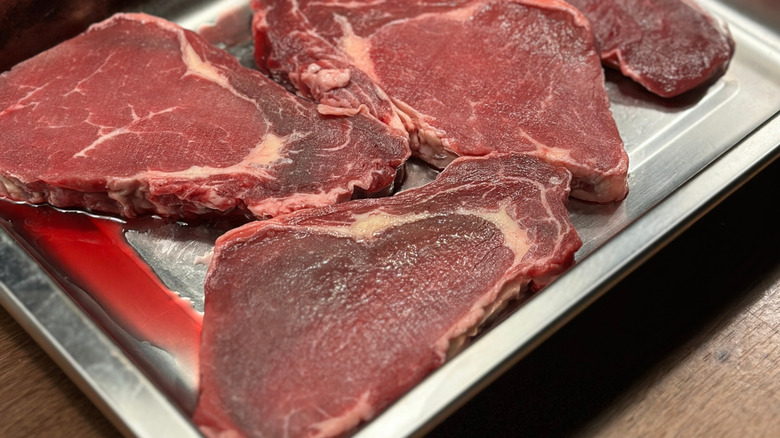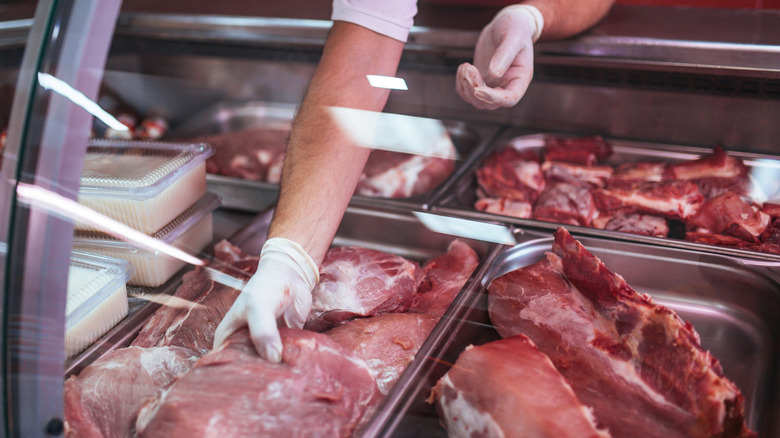One Red Flag Should Send You Running From The Grocery Meat Department
We often take for granted the subtle cues displayed by meat while browsing the grocery meat department. Either we assume that the meat is fresh, or we simply don't know how to tell if meat has gone bad. There are several indicators to be aware of, and we can think of 12 red flags you should never ignore in the grocery store meat department. One significant red flag is pools of liquid in the meat packaging. This liquid is often mistaken for blood because it is red and comes from the meat, but it is actually known as purge in the meat industry.
Purge is a mixture of water and meat proteins, one of which is myoglobin, and since myoglobin is what primarily gives meat its red color, it's not unreasonable to confuse purge for blood. The more myoglobin present in meat, the redder it appears. Additionally, because meat muscle tissue contains 70-75% water, this liquid — which is colored red by myoglobin — leaks from the meat and forms the pool of purge you observe.
You may be thinking that water and meat protein equal a red purge, not a red flag. However, the fact that meat is losing water is a warning sign. Meat's ability to hold water indicates its quality, and the more liquid it loses, the lower the quality of the final product. Several factors can contribute to this loss, including hereditary factors, handling of livestock, and storage temperatures.
Factors that cause purge in grocery meat
Purge occurs as the meat's ability to retain water changes during storage. This capacity decreases when the proteins that bind to water become inefficient. One condition that accelerates protein denaturation is the inheritance of a specific mutated gene (halothane), found in some pigs. Another contributing factor is aging. Once an animal is slaughtered and the meat begins to age, myoglobin loses its ability to retain water, contributing to purge. Additionally, factors influencing water loss begin long before slaughter, starting during harvest. If animals experience stress during handling, the harvested meat will suffer water loss in the form of purge.
The handling of animals after slaughter also affects whether the meat in your grocery store will have purge. One reason meat is chilled is to quickly lower its temperature. A lower temperature helps counter the rapid decline in pH and reduces the meat's metabolism rate. Successfully decelerating both mechanisms buffers the extent of protein denaturation and minimizes water loss. In other words, if you see purge, it may indicate that the meat in your grocery store's meat department wasn't chilled immediately after slaughter.
Purge lowers meat quality
Since purge contains the pigment myoglobin, meat loses some of its appealing red color as water drips out. Eventually, the meat becomes lackluster, sitting in a puddle of water and myoglobin. This less glamorous presentation tends to turn away customers seeking high-quality meat, as they associate purge with low standards. Additionally, the loss of valuable nutrients in the form of water-soluble vitamins and a large amount of protein provides little incentive to continue browsing the grocery meat department.
Perhaps the greatest loss associated with purge is flavor. A substantial amount of purge in the meat package indicates a lack of vibrant taste and, not surprisingly, tenderness. The more water lost, the less flavorful and juicy the meat becomes. Furthermore, the puddle of purge creates an ideal environment for breeding harmful bacteria that may cause illness if ingested. This is why other grocery meat has that absorbent pad in their packaging; it's a meat diaper. Its purpose is to absorb purge and reduce the chances of the meat spoiling, as well as to prevent contamination of other surfaces that may come into contact with harmful bacteria. Thus, though purge is generally safe to consume along with the meat, we suggest skipping any packages with excessive purge and perhaps even skipping the grocery store altogether in favor of your local butcher for better-quality meat.


